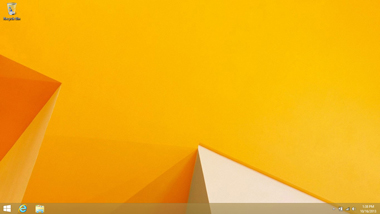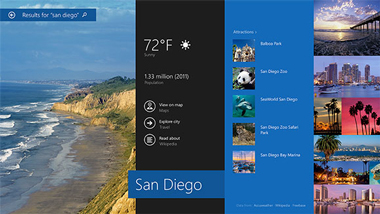News
Microsoft Fields Windows 8.1 Questions in Reddit AMA
- By Kurt Mackie
- October 22, 2013
Microsoft's Windows 8.1 engineers last week hosted a Reddit "ask me anything" (AMA) discussion to answer questions about the recently released Windows 8.1.
The Q&A session included responses from some of Microsoft's engineering team and product managers. Only a few of the questions got answered, though the discussion turned out to be a sprawling, 64-page thread. The highlights are summarized below.
Windows 8.1 Enterprise edition availability: Microsoft was asked when Windows 8.1 Enterprise edition would be available. Ian LeGrow, a Microsoft software manager, replied that the Enterprise edition is currently available for Microsoft's Software Assurance customers and that "evaluation edition" versions (good for 90 days) are currently available for TechNet subscribers (which can be accessed here).
The Enterprise edition of Windows 8.1 can be downloaded by Microsoft's volume licensing customers through the Volume Licensing Service Center. It can't be updated from the Windows Store, unlike retail or OEM versions of Windows 8, according to a Microsoft Springboard blog post. The Windows 8.1 Enterprise edition update can be burned to a DVD or USB drive and used for installations, or it can be used for "refresh"-type updates of Windows 8 via the Microsoft Deployment Toolkit (MDT) 2013 or System Center 2012 R2 Configuration Manager.
Organizations using a key management service for Windows 8.1 devices need a KMS server update before proceeding. Here's how Microsoft's Springboard blog describes the procedure:
"If you are using a down-level Key Management Service (KMS) to activate your Windows 8.1 devices, you will need to update your KMS server. The update is available for download now and extends the Key Management Service (KMS) for Windows Vista, Windows Server 2008, Windows 7, Windows Server 2008 R2, Windows 8, and Windows Server 2012 to enable the enterprise licensing of Windows 8.1 and Windows Server 2012 R2. New KMS keys are required to activate Windows 8.1; you can get your keys from the Volume Licensing Service Center (VLSC)."
Ian LeGrow of Microsoft suggested that the company would deliver an installer for volume licensees to use in upgrading to Windows 8.1 Enterprise edition.
"Upgrading from the [Windows] Store isn't supported for VL [volume licensing] installs, but we will be providing an installer on the Volume Licensing Service Center today [Oct. 17]; it will allow updates -- more news will come out later today."
Installing Windows 8.1 across multiple machines: A Reddit AMA participant asked about the availability of Windows 8.1 "standalone executables." The idea is to burn an install disk in order to copy Windows 8.1 across multiple machines, rather than having to use the single-machine update process accessed through the Windows Store. Apparently, only Microsoft's volume licensing customers and MSDN subscribers have this option to use Windows 8.1 install media to update multiple machines, per Microsoft's response.
"You have a couple options," replied Galileo of Microsoft. "If you are a volume license customer you'll have access to the bits for deployment there. Or, if you're a MSDN subscriber you'll find the .ISOs and .EXEs there as well. More info on deployment outside of the Store [is located] here."
Start button: The Microsoft team was asked about the return of the Start button in Windows 8.1, after its removal in the earlier Windows 8 release. Jason Beaumont, a group program manager on the user experience team at Microsoft, said that after debates and design studies, the team decided to listen to its customers and add the Start button back. "For [Windows] 8.1, we worked to enrich the Start screen while bringing back the flexibility for Windows users to easily transition between the Start screen and the desktop," he replied.
The Start button on the "Desktop" side of the Windows 8.1 user interface looks much like a white Windows logo pinned to the taskbar, according to this Microsoft-produced screenshot (Figure 1).
 [Click on image for larger view.]
Figure 1: Windows 8.1 Desktop with Start button (bottom left).
[Click on image for larger view.]
Figure 1: Windows 8.1 Desktop with Start button (bottom left).
What's still missing from Windows 8.1 is the Start Screen found in Windows 7. For those wanting something like it, it's possible to set up Windows 8.1 to boot directly to the installed Apps screen that's located on the Windows Store Apps (formerly known as "Metro") side of the Windows 8.1 user interface. An explanation of these configuration options can be found in this blog post by Joao Botto of Microsoft's Windows client OS team.
"Windows 8.2" and the new update cadence: The team was asked if Microsoft would push out operating system updates every year, and, if so, would Microsoft be expected to deliver the next version of Windows sometime in October 2014. In response, Katie Frigon, group program manager for the Windows user experience at Microsoft, offered a nonanswer. "Our goal is to continue to deliver updates on a regular basis to respond to customer feedback and improve and enrich the Windows experience."
However, Microsoft executives and engineers consistently have signaled that its customers should expect a faster software release cadence to come from Microsoft, including the suggestion that Windows would get an update once a year. For some product teams, there may be quarterly cumulative update releases, as has been suggested by Microsoft's Exchange team.
Line-of-Business Apps on Windows RT: The team was asked about developer support for line-of-business (LOB) apps on Windows RT systems, and when it will be possible for businesses to write their own LOB apps for Windows RT systems without having to publish them through the Windows Store. LeGrow suggested that Microsoft is still working on this issue.
"We hear from lots of folks large and small that are building LOB apps with WinRT now," LeGrow stated. "The work we did on WebView will help all app developers, but…a lot of the input came from LOB devs. Great question on the distribution. We've gotten a lot of feedback that we need to make it easier for smaller organizations -- nothing to say yet, but we're figuring this out."
Search change in Windows 8.1: The team was asked why the search function in Windows 8.1 requires the use of a sidebar now, instead of just allowing users to type at the Start Screen, as previously possible with Windows 8. There was no real answer to this question, but Frigon did offer a reply.
"If an app doesn't update or include a search control within their app, it is still easy to search within it," Frigon wrote. "Just bring in the Search charm, click on the Everywhere dropdown and select the app."
Microsoft's name for the search feature in Windows 8.1 is "Bing Smart Search" (Figure 2), which conducts searches across apps, files and the Web. Microsoft claims in a video that users can just type from the Start Screen to conduct a search.
 [Click on image for larger view.]
Figure 2: Bing Smart Search in Windows 8.1.
[Click on image for larger view.]
Figure 2: Bing Smart Search in Windows 8.1.
Screen scaling: A Reddit AMA participant commented that Microsoft's screen scaling controls in Windows 8.1 do not work independently for each individual screen device in multimonitor scenarios. Consequently text and objects can "appear larger on an external monitor." In response, James Clarke, principal program manager lead for Windows input and composition engine at Microsoft, said that "independent control of scaling for each monitor/device [is] great feedback -- we're definitely thinking about it."
Clarke also responded to a question about Google Chrome looking blurry across screens. He explained that the Google Chrome team is working to make Chrome more DPI (dots per inch) aware as an application.
"Another more general way to prevent the blurriness that can occur on apps that are not DPI aware or not per-monitor DPI aware on a per-app basis is to disable bitmap scaling of the app by opening the property sheet on the executable, switching to the compatibility tab and enabling 'Disable display scaling on high DPI settings' on the compatibility tab," Clarke explained. He added that Microsoft has introduced new APIs for developers that can help desktop apps "become per-monitor DPI aware," pointing to a Build talk and documentation (Word .DOC) on the topic.
In addition, Rob Mauceri, a partner group program manager at Microsoft, explained that zoomed content in an application currently stays fixed at that percentage across monitors.
"You can change the zoom level, but it will stick when you move the [application] window across monitors," Mauceri wrote. "I appreciate this feedback and having per-monitor zoom is something we're looking into."
Windows Store application vetting: The team was asked why apps mimicking first-party apps, such as Facebook knockoffs, were allowed in the Windows Store, potentially infringing software company trademarks. In response, Galileo of Microsoft said that Microsoft was trying to improve the Windows Store experience with Windows 8.1. He added that software developers with trademark infringement concerns would have to contact Microsoft to address those possible violations.
Unified App Store: The team was asked if Microsoft would deliver a unified app store housing apps for both Windows 8.1 and Windows Phone 8.1, which is something that outgoing CEO Steve Ballmer had suggested would be built. The team confirmed the project, with LeGrow stating that Microsoft is "working to make it as easy as possible for developers to build apps for both Windows phone and Windows. The platforms share core code, APIs and tools. We'll keep making this better with a goal of more and more unification. No dates yet."
Microsoft's name for apps in Windows 8, formerly known as "Metro": Microsoft was asked if it calls these Windows 8 applications either "Modern apps" or "Metro apps." Mauceri replied that "we call them 'Store apps.'"
It's thought that Microsoft officially changed the name of applications running full-screened, flat and chromeless on Windows 8 to "Windows Store Apps." Windows 8 also runs "Desktop" apps, which have a similar appearance to the apps that ran on Windows 7.
Windows e-reader solution: The team was asked if Microsoft had any plans to "build the Windows equivalent to the Newsstand and iBooks apps found on iOS" so that users wouldn't have to use Amazon's Kindle e-reader and could buy electronic books via a Microsoft account. In response, an unidentified member of Microsoft's team stated that it was "definitely on the radar and something we're working on!" This answer was interpreted as suggesting that a possible purchase bid for Barnes & Noble's Nook division might be in the works, according to a comment from the financial press.